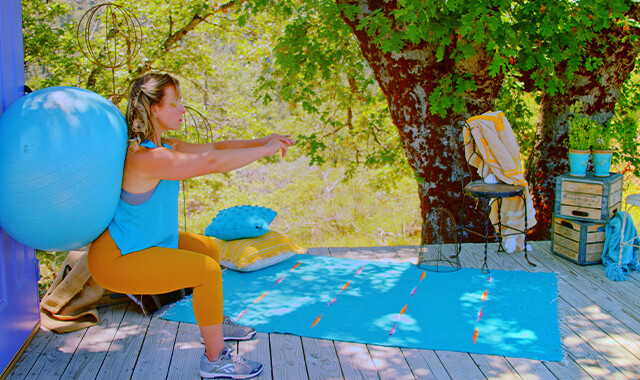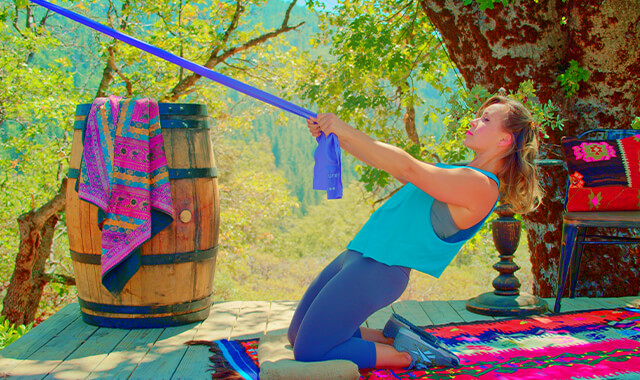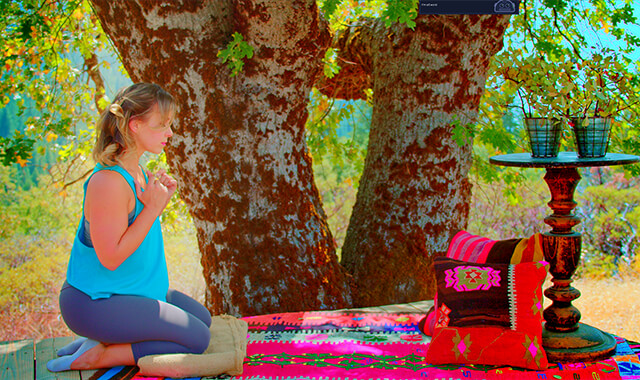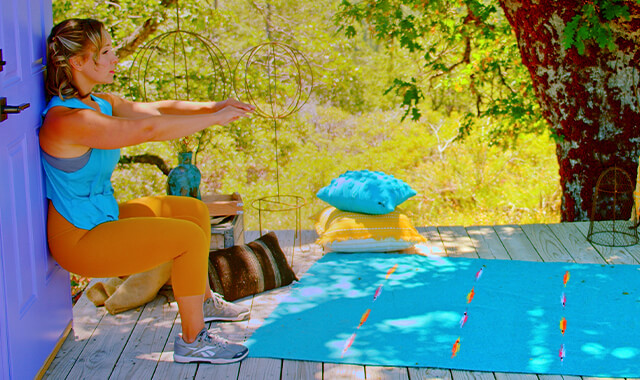Supported Reverse Nordic
How to Do Supported Reverse Nordic Curls - Bodyweight Kneeling Quad Exercise| In-Depth Guide [VISUAL LEARNERS] Beginner
Proper Form, Common Mistakes, & Variations | Home Resistance Training
WHAT DO YOU WANT TO SEE?
QUICK DEMO
QUICK DEMO
MUSCLES THIS WORKS
MUSCLES
MAIN MUSCLES WORKED IN the Supported Reverse Nordic
QUADRICEPS
OTHER MUSCLES WORKED:
- Iliopsoas
- Rectus abdominis
- Transverse abdominis
- Obliques
STARTING POINTERS
Starting Pointers
WHAT WE'RE DOING TODAY
ALL WE'RE DOING:
Leaning backwards a bit while on our knees
The Supported Reverse Nordic Curl is an effective beginner exercise for strengthening your quads at home. This variation of the kneeling Reverse Nordic uses two items, chairs work well, placed to either side of you. This is a good option if you have difficulty trusting your muscles to lower your back. Some people have difficulty being able to lean back and trust their muscles to support them. This is common if you have core or quadricep weakness, especially after injuries or surgeries (even abdominal surgery) If you try the standard version of the exercise and you cannot lean back without breaking at the hips or rounding your upper back forward, this is the right version for you. The chairs are there for support and guidance while you get used to trusting your muscles. The nice thing about this version is that you can slowly begin to lessen how much you are relying on the chairs, progressing to just finger touches on the seat, to one hand, and then just having them beside you but not using them.
HOW TO DO THE EXERCISE
LOOKS
HOW the Supported Reverse Nordic SHAPE OUR BODY
Increased size and definition of quadriceps (4 muscles on the front of the thighs). Can help with the definition of the abdominal “6-pack” muscle (as it also works the core muscles).
PROPER FORM
PROPER FORM: Supported Reverse Nordic
EQUIPMENT, SETS & REPS
EQUIPMENT
2 chairs or stools, coffee table and couch - any two items that can be placed one on each side of you.
Pad (folded towel or blanket, couch cushion) for under knees/lower leg.
SUGGESTED STARTING WEIGHT FOR WOMEN:
Limit/control the resistance by how far you lean back, do not progress this exercise too quickly. Make sure you are developing the ability to control the descent.
SETS & REPS:
2 - 3 sets to fatigue/failure
PACE:
Slow descent backward, back to start position can be quicker.
BODY POSITION
BODY POSITION FOR THE Supported Reverse Nordic
Position yourself between the two support objects. Your arms slightly at your side, just slightly in front- about the position you would hold onto rails to steady yourself. The shoulders and neck should be relaxed.
BODY STANCE: Tall kneeling, knees at a comfortable distance apart - hip width or slightly more narrow. Hips in neutral - straight with no crease at the front and knees bent to 90 degrees - straight in line with the hips, shins resting on floor/pad. Kneel on a pad if it is more comfortable; if your kneecaps do not tolerate direct pressure, put your shins on the pad but position your kneecaps over the front edge of the pad so there is no direct pressure on them.
Neutral spine. You should be able to draw a straight line down through your earlobe, shoulder, hips, and knees. Shoulder blades slide down and in. Sternum lifted. Neck in neutral.
FEET: Tops of your feet resting on the floor (toes pointed back), or ankles flexed with toes on the floor if that is more comfortable.
HANDS/ARMS: Place one hand on each of the support objects.
HOW TO DO
HOW TO DO the Supported Reverse Nordic
CUE: Use the support items as needed - trying to put as little weight on them as possible. The purpose of the support objects is to provide security as you build trust in your muscles to prevent you from falling back.
Slowly begin leaning backwards, keeping your alignment - earlobe-shoulder, hip, knee with no crease at the front of your hips. Make sure that the movement is coming from your knees only. So your knees are slowly bending.
As gravity acts to pull your body down your quadriceps are working to slow the movement down.
Once you feel that you won’t be able to maintain your form if you go further, hold the position for 1-3 seconds.
From this position, use your quadriceps to pull yourself back up into a tall kneeling position.
Repeat to fatigue/form failure: unable to keep your alignment - earlobe-shoulder, hip, knee with no crease at the front of your hips.
HOW TO SAFELY GET OUT OF THE EXERCISE
Step forward with one foot and press up to standing.

COMMON MISTAKES
COMMON MISTAKES
WHAT TO AVOID WITH THE Supported Reverse Nordic
KEY TIP:
Guess what? Good news! Many avoids are the same for most movements. Once you learn the basics, there's really only a few extra avoids for each individual movement.
1. Avoid Bending Spine
AVOID: Avoid rounding or arching your back. This is probably the most common error made.
WHY NOT?
- Leaning back can strain the back muscles.
WHAT TO DO:
- When you start to lean back the spine should not move out of a neutral position.
- The earlobes, shoulders, sides of torso, hips and knees should stay in a straight line (from a side view) during the whole movement.
- Activate the abdominal muscles to help hold the position.

2. Avoid Leaning Back Too Far
AVOID: Avoid trying to lean back too far.
WHY NOT?
- Your goal should be to feel the quadriceps and core muscles working, not how far you lean back.
- The quadriceps are holding the weight of your body up, leaning back too far could strain them.

3. Avoid Tightening Glutes
AVOID: Avoid tightening your gluteus maximus muscles.
WHY NOT?
- This can reduce the amount of work the quads need to do - the gluteus maximus will be helping to hold the hips in place.
- The goal of the exercise is for the quadriceps to be working to prevent gravity from pulling the torso down.
WHAT TO DO:
- It may be helpful to put your hands on your gluteus maximus to make sure they are relaxed.
- If you feel like you need to contract your gluteus maximus:
- Activate your lower abdominals and pelvic floor muscles
- Limit how far you are leaning back.

4. Avoid Bending Hips
AVOID: Avoid bending at the hips.
WHY NOT:
- Bending at the hips to get your bottom closer to your calves will give the illusion that you are leaning back but you will not be using your quads.
WHAT TO DO:
- Keep the front of the hips flat - hips in line with the shoulders and knees.

5. Avoid Leaning On Supports
AVOID: Avoid leaning on the support items.
WHY NOT?
- The support items are used to make you feel secure and to take a little bit of weight off of your legs as you lower your back.
WHAT TO DO:
- Keep your body upright, not leaning towards one of the support objects.

WHAT WE'RE DOING TODAY
WHAT & WHY
BENEFITS OF TRAINING THE quadriceps
WHAT
This is a way to work your quads that doesn't involve a single squat or lunge! The Reverse Nordic was the only quad exercise I could do for over a year while healing from a hamstring tendon injury. No squats, no lunges, no nothing else. During that time, I came to see how while squats & lunges are totally a great thing, it's also not the end of the world if you can't and/or don't want to. I was very grateful to have this exercise, and I found that because this is an eccentric-focused exercise, it's fantastic for injury prevention in the quads.
And while the Reverse Nordic is hard....it's also easy in the same vein because we're only moving at one joint (vs. squats/lunges involves moving at 3 joints! That's a lot going on and very fatiguing).
This exercise is done in a tall kneeling position - the hips are not bent (no crease at the front of the hip joint) and they stay in this position the whole time. All of the movement is through the knees. In this position, the spine is held in neutral (not rounded or arched).
The movement is pretty straightforward. Kneeling down on your knees, you align your body to make a straight line from head to knees. Then slowly lean back. As soon as the weight of the upper body moves back behind the knees, the effects of gravity can be felt. The muscles on the front of the torso and legs become active to prevent you from just falling over. The strong quadriceps muscles act as brakes, preventing the body from just falling backward. The spine may try to arch back, the abdominal muscles, including the rectus abdominis, known as the 6-pack muscle, will work to prevent the back from arching back.
No equipment is needed for this exercise and can be progressed easily to make it doable and challenging. One limitation of this exercise is that it only works the quadriceps through a small range of movement, which can be limited by tight quadriceps. The knee starts out bent to 90 degrees, and you may only lean back halfway - so maybe 40 or 50 degrees. In comparison, in a full squat (bottom down to heels), the knees may move through more than 130 degrees of motion.
WHY BOTHER DOING IT?
WHY
WHY DO WE EVEN CARE?
TRAIN LARGEST & STRONGEST LEG MUSCLES
The quadriceps are the largest and strongest leg muscles. We use them for nearly everything we do during the day, from quiet standing to running and climbing. They also play a huge role in keeping the spine, hips, knees, ankles, and feet in proper alignment to prevent damage to the muscles and joints.
ENABLES FOCUS ON 1 OF THE QUAD MUSCLES THAT YOU CAN'T TARGET AS WELL WITH SQUATS AND LUNGES
The quadriceps is a group of four muscles on the front of the thigh. All four of the muscles cross the knee joint and help to straighten (extend) the knee. Only one of the four muscles, the rectus femoris, crosses the hip joint and can help to bend (flex) the hip.
There are many exercises for strengthening the quadriceps muscles but most of them involve movement at both the hip and the knee at the same time. In exercises like squats, lunges, step-ups, the knee and hip are straightening at the same time. Since the hip is straightening while the knee is straightening, the rectus femoris is not as active, and the three other quadriceps muscles that do not cross the hip joint do most of the work to straighten the knee.
In the Reverse Nordic, the hip is not bent, this allows the rectus femoris to help with the movement at the knee joint. This is a great exercise to target all four of the quadriceps muscles.
ECCENTRIC FOCUSED EXERCISE = GREAT FOR INJURY PREVENTION
The Reverse Nordic focuses on eccentric contractions to strengthen the quadriceps and protect the muscle and joints from injury.
Eccentric training is beneficial because the muscle is able to produce more force while requiring less energy. Eccentric training is used for strengthening people with health issues, those that are very weak, old, or deconditioned, rehabilitation, and sports training to enhance performance and also prevent injury.
Knee injuries frequently happen during downhill activities because of the constant need to slow the weight of the body down, basically putting on the brakes the whole time. The Reverse Nordic trains your body for handling these activities much better.
EVERYDAY LIFE
EVERYDAY LIFE &
MUSCLE FUNCTION
HOW WE USE OUR quadriceps IN EVERYDAY LIFE
1. STRAIGHTENS (EXTENDS) THE KNEE/CONTROLS THE MOVEMENT WHEN THE BENDS (ECCENTRIC PHASE)
- Getting out of a chair, off the toilet
- Going up and down the stairs
- Walking
- Squatting
- Lifting heavy objects/kids from the floor
- Getting up and down from the floor/kneeling
2. STABILIZES THE KNEE JOINT
- During all standing and walking activities
3. THE RECTUS FEMORIS (ONE OF THE QUADRICEPS MUSCLES) BENDS (FLEXES) THE HIP
- Marching
- Getting into a car
- Going up the stairs
HOW TO FEEL WHAT MUSCLE IS WORKING
How to Feel What Muscle is Working
Seated in a chair, place your hand on the top of your thigh. Straighten the knee and you should feel the quadriceps muscles contract under your hand.
SCIENCY STUFF
SCIENCY STUFF
SPIFFILICIOUS FACTS ABOUT MUSCLES & MOVES
The four quadriceps muscles are the rectus femoris, vastus lateralis, vastus intermedius and vastus medialis oblique. The rectus femoris crosses the hip - its action is to flex the hip and to extend the knee. If the rectus femoris is shortened over the hip joint it is less able to contribute to knee extension. The four quadriceps muscles are joined with a common tendon, the patellar tendon. The tendon crosses the front of the knee joint and attaches on the tibia at the tibial tubercle, the bony prominence just below the knee on the shin.
The kneecap (patella) is a bone called a sesamoid bone - a bone shaped like a sesame seed that grows in a tendon. The patella is embedded in the tendon of the quadriceps (called the patellar tendon or the quadriceps tendon- all 4 muscles attach to it). It acts like a pulley to increase the angle of pull of the muscles to give them more strength. The patella rides in a groove in the end of the femur (thigh bone). The patella forms a joint with the femur called the patellofemoral joint. The back of the patella and the groove on the femur are perfectly matched. If you have weak quads or an imbalance in the muscles of the quad (sometimes a weak vastus medialis oblique), and/or a tight IT (iliotibial) band, the kneecap can ride on the edge of the groove as opposed to in the middle of it. This can result in wear and tear (osteoarthritis) of the back of the kneecap. Tight quads also contribute to this because when the quad is tight it compresses the space between the kneecap and the femur (the patellofemoral joint). That is why it is necessary to keep the quads strong and flexible in order to keep the knees healthy.
ALL MUSCLES & WHEN
ALL MUSCLES WORKING & WHEN DURING THE Supported Reverse Nordic
Core stabilizers: rectus abdominis, transverse abdominis, obliques, quadratus lumborum, and iliopsoas all work to hold the core stable.
From the starting position, the body is tilted backward, once the center of gravity is behind the knee joints the quadriceps will start working eccentrically to prevent the body from falling backward.
The force of gravity pulls the spine into extension because of the weight of the head and the long lever arm (knees to head). The rectus abdominis and iliopsoas will need to work harder to hold the spine in neutral. The other core stabilizers also need to work harder in this position.
The quadriceps contract concentrically to pull the body back up to the starting position.
PIN IT FOR LATER!










